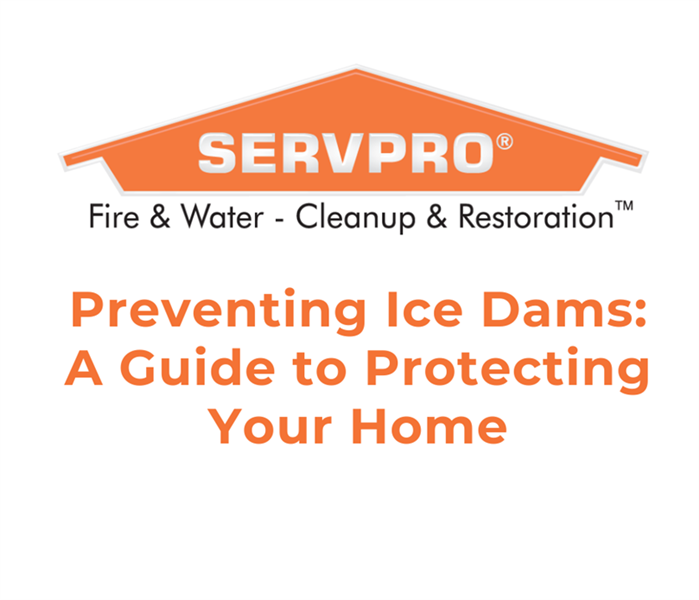Preventing Ice Dams: A Guide to Protecting Your Home
10/18/2023 (Permalink)
 By taking proactive steps to insulate your home, improve ventilation, and practice regular maintenance, you can reduce the risk of ice dams
By taking proactive steps to insulate your home, improve ventilation, and practice regular maintenance, you can reduce the risk of ice dams
Winter can be a magical time of year, but it also brings its fair share of challenges, especially for homeowners in Framingham MA. One of the most common and potentially damaging issues during the winter months is the formation of ice dams on your roof. Ice dams not only pose a danger to your home's structural integrity but can also lead to costly repairs. However, with the right knowledge and proactive measures, you can prevent ice dams from forming and protect your home. Learn what ice dams are, why they occur, and most importantly, how to prevent them.
Understanding Ice Dams
Ice dams are ridge-like accumulations of ice that form at the edge of your roof. They prevent melting snow and ice from draining off your roof, leading to water backing up and potentially seeping into your home. The process typically unfolds as follows:
- Snow Accumulation: A layer of snow blankets your roof.
- Heat Loss: Heat from your home escapes through the roof, causing the snow on the upper section to melt.
- Freezing Point: As the melted water reaches the lower, colder portion of the roof (usually near the eaves), it refreezes, forming a dam of ice.
- Water Backup: More snow continues to melt and flow toward the ice dam, eventually creating a pool of water that can find its way into your home through gaps in your roof or siding.
Why Preventing Ice Dams is Crucial
Ice dams can wreak havoc on your home in several ways:
- Roof Damage: The weight of ice dams can damage your roof's structure and shingles, leading to costly repairs.
- Water Damage: As the ice dams trap water on your roof, it can find its way into your home through ceilings, walls, and insulation, causing extensive interior damage.
- Mold and Mildew: Moisture infiltration can foster the growth of mold and mildew, which can pose health risks to your family.
- Energy Loss: Ice dams often form as a result of heat escaping from your home. This means you're losing valuable energy and driving up your heating bills.
Preventing Ice Dams: Tips and Techniques
Now that you understand the potential risks, let's explore some practical steps to prevent ice dams:
- Proper Insulation: Ensure your attic is well-insulated to prevent heat from escaping through the roof. Adequate insulation will keep the roof temperature uniform, reducing the chances of ice dam formation.
- Ventilation: Install roof and soffit vents to allow cool air to circulate through the attic. This helps maintain a consistent roof temperature, preventing snowmelt.
- Seal Gaps and Leaks: Seal any gaps, cracks, or openings in your roof, walls, and attic to minimize warm air leakage.
- Attic Air Sealing: Air sealing your attic can prevent warm air from escaping into the attic space.
- Roof Raking: After a heavy snowfall, use a roof rake to remove excess snow from the lower sections of your roof. This reduces the amount of snow available for melting and ice dam formation.
- Ice Dam Membranes: Consider installing an ice and water shield membrane under your roofing material, especially near the eaves, to prevent water infiltration.
- Gutter Maintenance: Keep your gutters clean and free of debris, allowing for proper water drainage. Consider installing heated gutter cables to prevent ice buildup.
- Professional Inspection: Schedule regular inspections with a roofing professional to identify and address potential issues before they become major problems.
Ice dams are a common winter woe for homeowners, but they are not insurmountable. By taking proactive steps to insulate your home, improve ventilation, and practice regular maintenance, you can significantly reduce the risk of ice dam formation. Preventing ice dams not only preserves your home's structural integrity but also keeps your energy bills in check and ensures a cozy, dry winter season indoors. Remember, a little prevention now can save you a lot of trouble and expense down the road. Stay warm, stay dry, and enjoy the winter season to the fullest in Nobscot, MA!
SERVPRO® Of Framingham is The #1 Choice in Cleanup and Restoration for residential and commercial buildings’ fire, mold, water, and storm damage. Call us today (774) 540-6950





 24/7 Emergency Service
24/7 Emergency Service